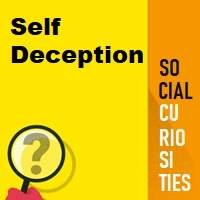
The Self-Deception Experiment
Self-deception is a process of denying or rationalizing away the relevance, significance, or importance of opposing evidence and logical argument. Self-deception involves convincing oneself of a truth or lack of truth so that one does not reveal any self-knowledge of the deception.
People lie all the time even to themselves and surprisingly, it does work! This is the finding of the Quattrone and Tversky social psychology experiment that was published in the Journal of Personality and Psychology.
Everyone is guilty of self-deception especially in the occasion where we don’t end up getting what we wanted. We tend to rationalize ourselves and tell ourselves that what we instead got is better than what we originally wanted anyway and then we learn to settle. Sometimes it can be as obvious and direct as this, but there are also times when we do it to ourselves unknowingly and without even being aware of it.
Quattrone and Tversky further explored this phenomenon of self-deception in their classic social psychology experiment in 1984. It was then published in the Journal of Personality and Social Psychology.
The Experiment
The researchers recruited a total of 38 student respondents who were informed that they were to participate in a study about the “psychological and medical aspects of athletics”.
The truth was, that the researchers were tricking the participants into thinking that the span of time that they will be able to submerge their arms in cold water tells them their current health status. This consequently allows researchers to find out how readily people deceive themselves to achieve more desirable results for themselves.
First, subjects were instructed to submerge their arms into cold water for as long as they could stand.
Next, the subjects were given some other tasks to do to make them think they were really involved in a study about athletics. They were asked to do some bike exercises, among others.
The subjects were then given a short lecture regarding life expectancy and how this relates to the type of heart each person has. They were informed of the two types of heart namely:
- Type I heart which is associated with poorer health, shorter life expectancy and more vulnerable to heart disease.
- Type II heart, which is associated with better heath, longer life expectancy and lower risk of contracting heart disease.
Half were told that people with Type II hearts are expected to have increased tolerance to cold water after exercise, while the remaining half were told it decreased tolerance to cold water. But these are not factually right anyway and were just made up lies to see whether participants will be deceiving themselves to think this way or not.
Subjects where then asked to submerge their arms again into the cold water for as long as they could stand.
The Results
The results acquired by Quattrone and Tversky showed that the experimental manipulation was effective. For the first half whom was told that cold tolerance is healthy, subjects were able to submerge their arms in cold water much longer the second time compared to the first time they did. At first, they averaged at 35 seconds but during the second attempt, they lasted longer than 45 seconds.
On the contrary, the other half whom was told that cold tolerance is unhealthy, correspondingly lessened their submersion time. On the average, when they first submerged their arms in cold water, they lasted for around 45 seconds. But after being informed about their heart type, their time went down on an average of 35 seconds.
Apparently, as results show, when people thought higher cold tolerance meant healthier heart, they held their arms underwater much longer and those who believed the reverse did otherwise and felt they couldn’t any longer tolerate the cold.
To further test whether subjects were self-deceiving, they were asked whether they intentionally held their arms underwater longer or shorter as it indicates the health of their heart. Among the 38 subjects, 29 denied they did and 9 confessed indirectly. Those 9 justified that the water had changed temperature, thus explaining the change, but of course the water just had the same temperature all throughout the experiment.
They were then asked whether they really do believe that they had a healthy heart or not. More than half of the subjects that denied or 60% of them thought they had the healthier type of heart. While among the 9 confessors, only 20% thought they had the healthier heart. This only means that the deniers were more likely to be really deceiving themselves because they thought that the test was really telling them that they had a healthy heart.
The subjects confused diagnostic effect with a causal one. Submerging their arms for more or less time in the cold water is diagnostic of whether you have a healthy heart or not and does not cause a change in your heart’s type. With this in mind, the subjects behaved as if they can actually change their heart’s type.
The Conclusion
The experiment shows the different graduations of self-deception. At the highest level, people tend to imbibe the deception and therefore think and act as though their incorrect belief is completely true, totally ignoring and rejecting any incoming hints from reality.


